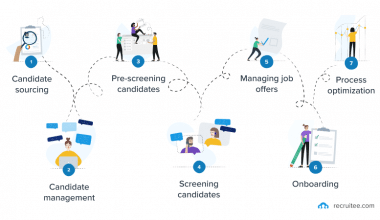Inventory management systems keep track of how many items a company or business has on hand, how many have been sold, and when to place new orders. For some small firms, the inventory tools that come with accounting software and point-of-sale systems are sufficient, but more sophisticated businesses could need third-party apps.
To choose the best solution for you, take into account your industry, the supply chain stages you need to monitor, integrations, and the user interface.
The correct software will simplify daily tasks and provide insightful data. This will be accomplished while preventing you from paying extra for features your company doesn’t require.
Best Inventory Systems for Small Business
In this article, the inventory systems have been arranged into niches where they fit. Now let’s take a look at them below.
Best for e-commerce businesses
#1. Veeqo
Veeqo’s pricing is based on both plan tier and the volume of orders a company handles each month, unlike some of its rivals. The software provides reporting, purchasing, shipping, and order management tools for businesses with one warehouse or multiple warehouses. It was created specifically for e-commerce businesses.
#2. Cin7
Small businesses, business-to-business, business-to-consumer, and enterprise businesses can all benefit from Cin7’s tailored plans. Email and live chat assistance are included with all plans.
#3. Brightpearl
Brightpearl is an option for e-commerce companies that require a comprehensive solution for managing their retail operation. The retail operating system includes a POS system and an integrated customer relationship management solution in addition to e-commerce inventory and order management. It stands out since it provides clients with infinite, cost-free user additions.
Best for Retail Businesses
#1. Lightspeed Retail
A POS system with integrated inventory management capabilities is called Lightspeed Retail. Business owners may fill out purchase orders from within the software and make bulk price changes across sales channels in addition to keeping track of their inventory. Reorder points and low stock warnings can also be configured.
#2. Agiliron
Agiliron, which is a POS system with inventory management features similar to Lightspeed Retail, is intended for merchants, wholesalers, and distributors who sell goods through various channels. All subscriptions include customer relationship management and QuickBooks connection, but advanced inventory management is only available to middle-tier plan subscribers.
#4. inFlow inventory
To get business owners started, all inFlow programs include two hours of individualized setup support and demonstrations. For companies who need to inventory the items in a store or warehouse, the hardware range of the company includes a handheld scanner. In addition to serving small businesses, the organization works with major corporations like Google, Volvo, and NASA.
Best for Restaurants
#1. Restaurant365
Restaurant365 is a software for managing restaurants that can calculate recipe prices and compare real-world food costs to estimated ones. The platform can directly interact with more than 100 POS systems and has its own accounting software.
#2. Partender
Bartender, a program designed exclusively for bars, permits unlimited users on all plans and allows servers to check the amount of alcohol in each bottle as well as add new ones. The program then informs business owners of what is and is not selling well.
Best for Manufacturers
#1. SOS Inventory
SOS Inventory is intended for manufacturers that use QuickBooks for accounting and need more advanced inventory management capabilities. The company’s basic inventory plan comes with two users and lets clients add additional users for $20 each.
#2. Goods Order Inventory
Like SOS Inventory, Good Order Inventory is meant for entrepreneurs who use QuickBooks for accounting. Business owners can use it to manage inventory across locations and sales channels and fulfill orders from within the software.
#3. Katana
Katana is an enterprise resource planning software for manufacturers, meaning it has capabilities that stretch beyond inventory management, like sales, production, and custom workflows.
Best Desktop Inventory Software
#1. QuickBooks Enterprise
QuickBooks Enterprise, a desktop accounting software product with optional cloud access, comes with advanced inventory functions, including cost-of-goods tracking. Business owners who already use QuickBooks Enterprise might try out its built-in inventory features before integrating with a third-party app.
#2. Fishbowl
Fishbowl Manufacturing interfaces with both QuickBooks Online and QuickBooks Desktop, thus it isn’t just a cloud-based solution. User licenses are perpetual, but if business owners want access to software upgrades, they must renew.
Best Inventory Software With Free Plans
#1. Zoho Inventory
The free version of Zoho Inventory allows for one warehouse, 50 orders, and 50 shipping labels per month. Due to their smooth integration, this is a wonderful value for business owners who currently use Zoho tools, such as Zoho Books for accounting.
#2. Square for Retail
Basic inventory management options like low stock notifications and barcode scanning capabilities are part of Square for Retail’s free point-of-sale software plan. Retail establishments that already use Square might wish to give it a try and, if it isn’t adequate, think about upgrading POS plans or connecting with a different inventory management tool.
#3. SalesBinder
SalesBinder, in contrast to Square for Retail, is an inventory management program that interacts with QuickBooks Online, Xero, or Zapier rather than a point-of-sale system. Business owners can manage up to 100 inventory items, accounts, or orders using the software’s Forever Free plan. Paid plans start at $9/month and can track a lot more inventory items.
#4. Sortly
Owners of businesses can manage up to 100 items with Sortly’s free plan. A wide range of businesses, including those in construction, medicine, government, information technology, and jewelry, can use the program. Owners of businesses who need multiple users can think about subscribing to a paid plan.
#5. Inventory Now
For resellers, Inventory Now is an inventory program that provides them some flexibility in how they wish to track their inventory. When a customer is making an in-person purchase, they can either use a shopping cart checkout feature or indicate a product’s status as it progresses along (purchased, sold, delivered, etc.). The app’s free plan has a limit of 20 inventory items.
#6. Ordoro
Basic shipping and return features like the ability to generate return labels and gain access to USPS prices are included in Ordoro’s free plan. Businesses that process more than 1,000 orders monthly must pay a plan fee of at least $20 per month.
Inventory Systems for Small Business Free
Although it can be very expensive, inventory management software is a crucial component of launching and maintaining a business. You may reduce costs by using these free inventory software choices, and they actually work. Even though they might not all have the fancy features of the software that cost money, they might have just what you need for your small business.
Most free small business inventory software or systems apply some sort of rule, but the restrictions vary depending on the product. Some free inventory management software places a ceiling on the number of orders or customers you can add, while others limit the number of warehouses and sales channels you can manage. Furthermore, many of the choices we provide only let you employ a small number of software connectors.
Below are our small business top picks for inventory systems
#1. Canvus’s Stockpile: Best for unlimited items and users
You may import and add inventory, keep track of stock counts, accept refunds, and more using Stockpile by Canvus. Additionally, the software allows for the transfer of inventory from one location to another and enables photos and labels for inventory items. Along with inventory transactions, stock transactions, and daily transactions reports, reports also feature a list of the current stock counts.
#2. Sortly: Best for industry-specific guidance
Price: Free 14-day trial of the Advanced or Ultra plans, with monthly billing ranging from $0 to $119. Enterprise-level solutions are also available with custom pricing.
Only one user can use the free Sortly inventory software; however, you can add three, five, or more users by upgrading to the Advanced, Ultra, or Enterprise plan. You may manage inventory remotely by using the Sortly app to make any adjustments or upgrades to your system. For customer help, there is a ticketing system and an online knowledge base.
#3. Zoho Inventory is the best scalable inventory software.
Price: $0 to $299 per month (when invoiced monthly); free 14-day trial for commercial versions.
The free inventory software from Zoho enables one warehouse, 50 orders, and after-ship tracking each month. Additionally, 50 shipping labels are provided each month. In addition, Zoho offers four different subscription levels based on the number of warehouses and orders your company manages. Major e-commerce accounts like Amazon, eBay, and Shopify are integrated.
#4. SalesBinder: Best for handling multiple locations.
Price: Free 30-day trial for paid versions; from $0 to $99 per month.
The free inventory software from SalesBinder can be an excellent choice if you simply need 100 records and one user. However, the web-based inventory management program does provide subscription solutions with more features if you have more complex inventory management requirements. There is an iPhone app, but there isn’t one for Android.
#5. Stock control: Best for business owners who only require a basic iPhone app
Price: It’s free with in-app purchases.
You can manage your inventory across numerous groups and locations with the help of stock control. This is especially helpful if you need to manage inventories for multiple companies or if you want to keep track of your personal inventory separate from your business. However, the free version only allows for 15 items.
#6. Boxstorm: Best integration with QuickBooks Online
Price: $0 to $79 per month.
The creators of Fishbowl provided this free inventory software solution. You can upgrade to a paid version if you want unlimited locations, items, and transactions, though additional users will cost you $9 per month. It is only limited to one user, one location, and 25 items. Users of QuickBooks Online can use Boxstorm, which is available for iOS and Android devices.
Which Inventory System Do Most Businesses Use?
Smaller companies frequently employ the periodic inventory system since their inventory is simple to handle and they may not have the resources or opportunity to integrate computerized technologies into their workflow.
What are the 4 types of inventory?
#1. Raw material
At its most fundamental level, your inventory is referred to as raw materials.
This is the component that will turn your inventory into the finished product at the first stage of production.
#2. Work-in-progress
Work-In-Progress inventories, or WIP inventories for short, are inventories that are currently being worked on. It is literally your semi-finished items or any unfinished products, as the name would imply.
Things that would be evaluated, from a cost standpoint, WIP would include raw supplies, labor, and any overhead expenditures. It also refers to the inventory required for the sale of your finished goods.
#3. Finished Goods
In the entire procedure, this is the stage that is easiest to comprehend. You are showing the consumer your inventory of finished goods. These are products that are offered for sale. Essentially, any product that is ready to be sold is considered a finished product.
Overhaul/Maintenance, Repair, and Operating Supplies (MRO). The specifics are what an overhaul or MRO inventory is all about. While not exactly a part of the product, inventory is needed to assemble and sell your finished goods.
These are not necessarily the raw materials needed but are also needed to keep a company running. If you manage an office, office supplies and stationery would also fall under this heading.
What Is the Best Way to Keep Track of Inventory?
A user-friendly, powerful inventory management software system is the finest tool for keeping track of inventories. You can use barcodes and QR codes to automate otherwise laborious, error-prone operations, receive real-time warnings, and add useful photographs to your inventory list with inventory management software.
What is the 80/20 rule in inventory?
The 80/20 rule states that 80% of results come from 20% of efforts, customers, or another unit of measurement. When applied to inventory, the rule suggests that companies earn roughly 80% of their profits from 20% of their products.
How do you keep track of inventory in Excel?
Create a spreadsheet. To manage your inventory in Microsoft Excel, begin by creating a new spreadsheet.
- Add any necessary product categories as columns.
- Add each product that you carry to the spreadsheet.
- Adjust the quantities as you make sales.
Conclusion
Understanding your inventory and knowing what to do at each stage is essential to successfully manage a firm with an effective supply chain. In this manner, you can arrange every element and keep tabs on your stock in case of any kind of stock problem. The lifeblood of your firm is inventory. Except you have a very simple inventory that you can keep using a spreadsheet, inventory management software can save you time, headaches, and money.
The task is made simpler with the correct inventory management software. There are several that operate independently or with accounting software, while many are connected to point-of-sale systems.
There are numerous inventory systems for small business programs available to suit a wide range of requirements. Because of its low cost and simplicity of use, we determined that Zoho Inventory is best suited for the majority of small enterprises. It provides the key functions required to manage a successful store and e-commerce program.
Inventory Systems for Small Business FAQs
What type of Inventory system does Amazon make use of?
Amazon uses a perpetual inventory system. That’s because of the sheer volume of goods that go in and out of its warehouses.
What is the best Inventory system for small businesses?
Zoho Inventory.
What is the most commonly used inventory system?
Periodic inventory system.
Does QuickBooks track inventory?
Yes, it does in fact, QuickBooks Online has everything you need to manage your inventory.
Related Articles
- How To Calculate Average Inventory- A complete Step-by-Step Guide
- Zoho Reviews 2022: Can Zoho Be Trusted?
- QuickBooks Accountant: Basic Guide for Optimal Results (+ Quick Tools)
- QuickBooks Accountant: Basic Guide for Optimal Results (+ Quick Tools)
- Sales Order Management Software: Top 25 Order Management Software






